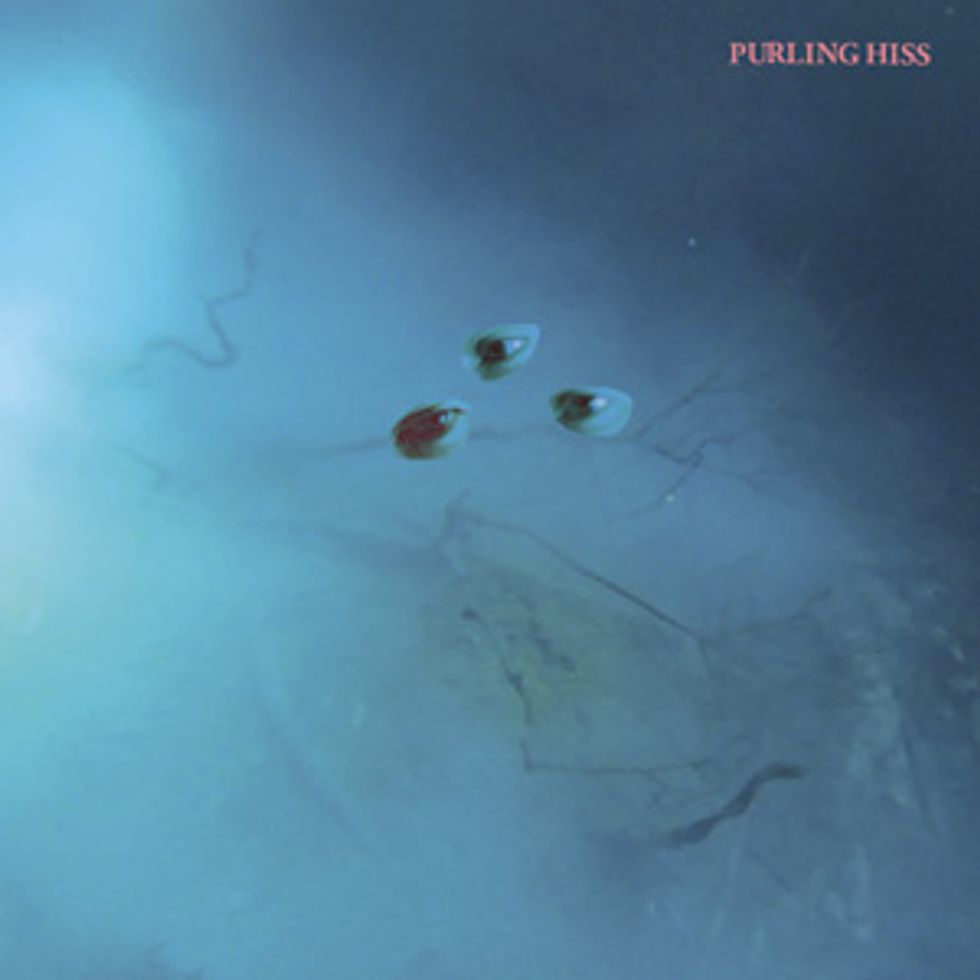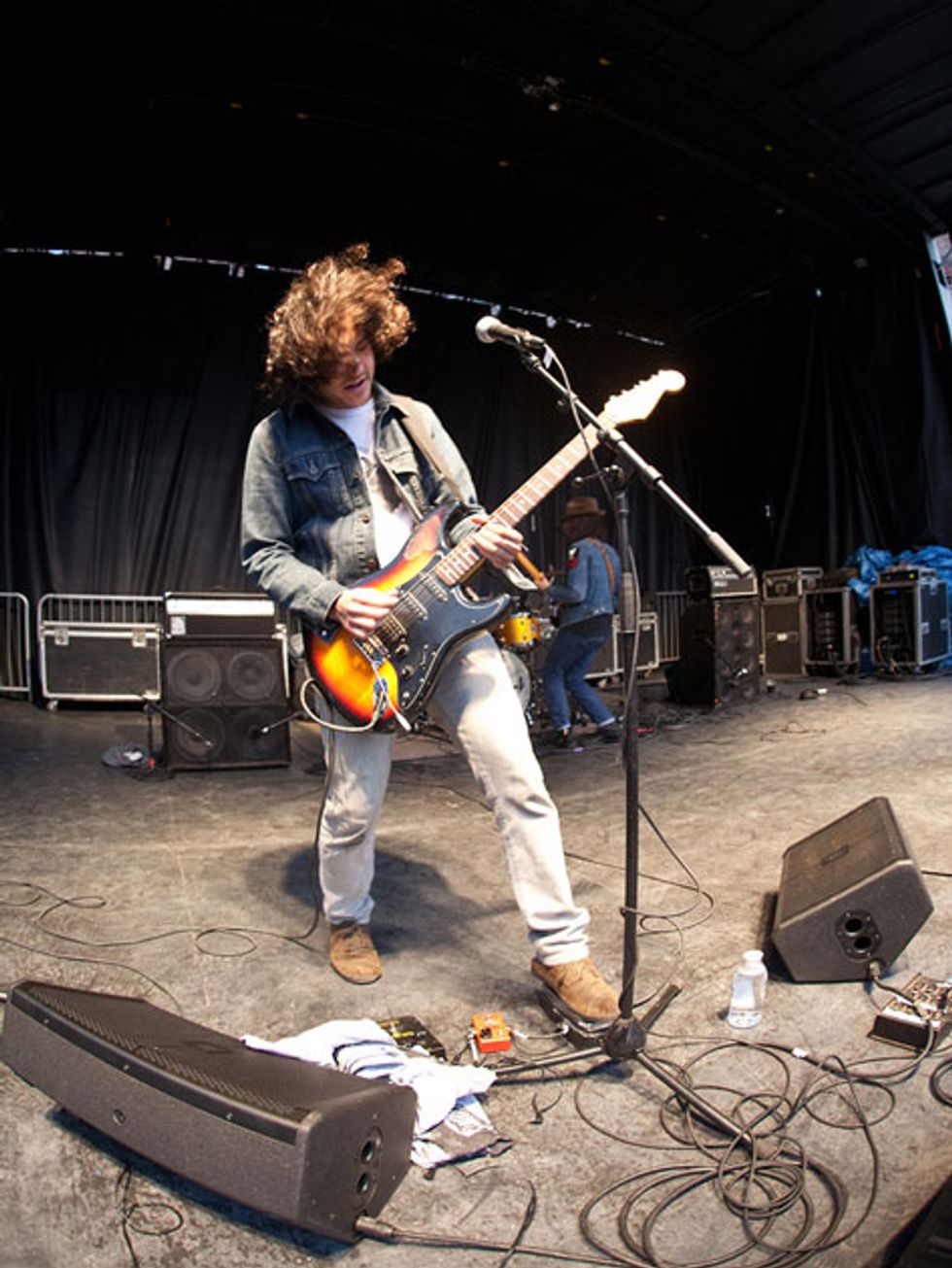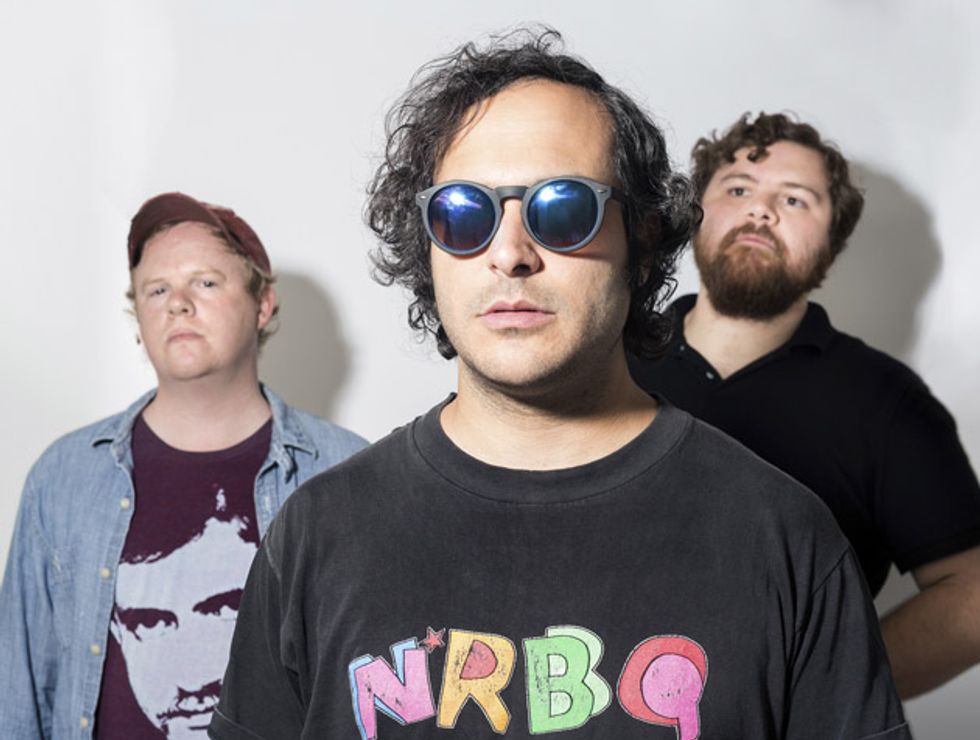If you’re into gear—and you probably are if you’re reading this—the first thing you’ll notice about Mike Polizze, the guitarist in Purling Hiss, is his amp: a modded Ampeg VT-22.
You don’t see many Ampeg guitar amps these days, but they were a big deal in the early ’70s—especially for the Rolling Stones. The Stones were the first band to use Ampeg’s muscular V series and they brought the prototypes on their 1969 American tour. It was on that tour that Bill Wyman introduced the world to the SVT (his was a-300-watt, 95-pound beast), and those are the amps you hear on Get Yer Ya-Ya’s Out!, the Stones’ 1970 live album. Mick Taylor used a V series amp for his iconic solo on “Midnight Rambler” and they were still using those amps on Exile on Main Street in 1972. The Stones pushed their amps hard, and for that 1969 tour had a tech on loan from Ampeg to manage their backline if it melted down.
Polizze doesn’t push his amp that hard, but it is the bedrock of his tone—he is a pedal minimalist—and he keeps it loud. Onstage, he often faces his VT-22 to coax feedback from his Hughes & Kettner 4x12 cab. In the studio, he does the same thing. “We tried to baffle it as best as possible,” he says about the live tracking for Purling Hiss’ latest release, High Bias. “We had a big foam thing that we put over the amp. We used headphones, but it still felt live.”
That live, improvisatory feel is the next thing you’ll notice about Polizze. His band isn’t a jam band per se, but he leans toward the loose and spontaneous. It is a debt he probably owes to Hendrix. “The album that really got me into Hendrix was Gypsy Sun and Rainbows from Woodstock,” Polizze says. “That recording is just great. It’s sloppy and it is really unhinged and beautiful. That was a big one for me in the beginning.
Unhinged is a good way to describe Polizze’s early Purling Hiss records as well. The project started as noise experiments recorded to a 4-track cassette machine while Polizze was busy with his other band, Birds of Maya. He played all the instruments and sometimes even recorded the drum parts first. Those tracks were released as Purling Hiss in 2009 and followed by two more albums the next year.
And Purling Hiss may have remained a quirky, if interesting, side project had not fellow Philadelphian Kurt Vile invited Polizze to assemble a band and open for him on a North American tour. Since then, Purling Hiss has taken on a life of its own. Polizze has upgraded to recording in a bona fide studio, brought in others to produce—including Adam Granduciel (the War on Drugs), yet another fellow Philadelphian—and no longer plays bass and drums for the band in the studio.
Polizze is evolving, but he keeps it open-ended and is willing to let the cards fall where they may. “It’s about being on the spot,” he says. “That’s the type of creativity it is. It’s like occupying the space of a certain tempo or time and feeling your way through it as it happens.
We spoke with Polizze about his songwriting, improvisation, recording at home, and mastering on GarageBand. We also spoke about keeping his Strat in tune—despite overworking its stock whammy—and learned what’s different about his Ampeg VT-22.
When did you start playing?
I started playing guitar when I was 13. I am 35 now.
Did you take lessons?
I did. I started taking piano lessons when I was in second grade, when I was about 8. I took piano lessons up until about ninth grade and then I started taking guitar lessons. I think at one point I was taking both. It helped a lot, although I was always slow at reading music.

Gone are the 4-track tape recorder days. The new Purling Hiss album, High Bias, was cut live in the studio with Polizze’s Ampeg VT-22 set on “stun” and baffled with a foam cover.
Did you spend a lot of time in high school shedding and learning the instrument?
Yeah. I look back now and I’m happy—I was certainly having fun then—but it was just nerding out, just shredding. I went through a phase when I first started where I wanted to play and I wanted to be a good player. When I got into my early 20s, I think I was at a crossroads where I thought, “So what if I can play this stuff? It doesn’t mean it’s cool. It doesn’t mean I am creative.” I had a period where I wasn’t sure what to do with it. That was a period where I had to find my identity as an artist. I think I have a good vantage point now. I’m glad that I woodshedded back then and worked out and found my identity through it.
When did you start writing songs?
That’s the thing—I don’t think I realized that I did. I used to draw a lot when I was a kid. I was creative and I came up with ideas. I wasn’t the best illustrator, but I feel like I got reactions from people. I made funny cartoons and the idea would be there. Recently, I realized that was the creative part. To me, drawing well is the same as playing guitar really fast. It doesn’t mean there is an idea there. I had a band in high school, too, so technically I was writing songs on guitar as soon as I started playing. But I feel like it all came to fruition when it became Purling Hiss, because that is a name I stuck with. I look back at some old recordings and it is funny how many different styles I went through. I was searching for what was for me and what wasn’t for me.
Did Purling Hiss start as demos on a 4-track cassette machine?
Yeah. I still have the same 4-track. It’s a Yamaha MTX4 4-track cassette recorder. I bought it when I was 18, the year I graduated high school. I’ve always been recording on it. The songs I ended up using for the first Purling Hiss recordings are from around 2007 or 2008. I was doing a noise experiment, a guitar experiment, and I came up with a name—purling means the rippling effect on a stream—and I thought that sounded cool. I kept the name and it was just another 4-track recording I was doing. I didn’t even have a band yet. I didn’t get a band together until I started putting out records on small labels and then people started asking me to play live shows.
The current version of Purling Hiss includes drummer Ben Leaphart (left) and bassist Daniel Provenzano (right), and is the most flexible, improvisation-inclined version of Polizze’s band to date. Photo by Constance Mensh
Did you dump those tracks into Pro Tools to create the album?
It’s kind of funny, but no, I’ve always been really simple with recording. I’ve always used my Shure SM57—the flat one, the instrument mic—I’ve always used one of those for everything. Then, from my 4-track, I would dump it into GarageBand. I digitize it, bounce it to iTunes, and that would be it. It was rudimentary and really crude—on purpose in a way. I was like, “This is it.” I recorded analog first, so it would be to tape, but I had to digitize it somehow.
Did you mic everything or did you record some instruments direct?
I wanted to be as uniform as possible. I wanted it to sound cool. I miked the bass, too. I plugged my bass into my Ampeg VT-22, it’s like a V-4 [tube bass head], and recorded it that way.
Has any of that spirit carried over into the current project, with a full band and recording in a regular studio?
It’s more straightforward now. We record live as a band and I do some overdubs, but I’m basically using my same gear.
When you started playing the older material live, did you expect the other musicians to play what you recorded or did you give them latitude to reinterpret the music and play what they wanted?
It really depended on the people, but I was always the primary writer and I said, “Here’s how the song goes.” If they did something on their own and it fit, I was fine with it. With the newer stuff, I still do the same thing. At practice I say, “Here’s a song I wrote.” They can make up their own parts if they want to, as long as it fits. I impart a certain vibe to it, a feel to it. It’s always been that way. It’s my project, but we work it out together.
Do you jam a lot as well?
With the old band, I just told them how to play it because we didn’t have much time and we had to get on the road. But in the last year, with the band members I play with now, we’ve started jamming more, which has been good. It’s been more open recently and I think that came through on the new album, too.
A lot of your songs are conducive to jamming.
Totally. A lot of the stuff we do and the creative process is sort of off-the-cuff. It is not preconceived. Sometimes it is, or I’ll write it that way on purpose and try to make it like a controlled thing, but I’ll leave a lot of open-ended-ness. We do repetition and a lot of improvisation. I like that a lot. I like the aesthetic and feel of that.
Do you listen to any open-ended or free music, and are you trying to incorporate some of that into your playing?
I listen to a lot of improv—anything from noise stuff to jazz stuff—anything that provokes or encourages off-the-cuff, in-the-moment playing. It could be anything: completely free jazz like Ornette Coleman or, more specifically, like on my song, “Ostinato Musik,” which is my little homage to Manuel Göttsching, the German guy who played in Ash Ra Tempel. He has an album called Inventions for Electric Guitar. It’s great stuff. He uses a lot of delay and a lot of repetition. Those are just a couple of examples. It’s not about being in a jam band or anything like that. It’s about being on the spot—that’s the type of creativity it is. It’s like occupying the space of a certain tempo or time and feeling your way through it as it happens.
You use a lot of repetitive figures in your solos as well.
On the last track of the album, “Everybody in the USA,” we wanted to do something like that. Half the song has structured parts and then we open it up at the end. There are two searing solos at the end and it was completely first take on both. That’s an example of where we do it on the album—where there is a lot of improv. Traditionally, you get a lot of rock bands that do a rhythm track and then have a lead track, whereas these are both. I recently saw that Iggy and the Stooges documentary, Gimme Danger, and they were talking about recording Fun House. Ron Asheton, or someone, was talking about Ron Asheton’s guitar playing. They were saying, basically, “It is rhythm guitar! No, it’s lead guitar!” I heard that and I thought, “That’s exactly how I feel.” I feel we were doing that at the end of our last track: this swelling, searing, slow bass and drums, and swelling and occupying the space with the guitar and sounds.
Mike Polizze’s Gear
Guitars’90s Fender Stratocaster
1970s Strat (backup)
Amps
Modded Ampeg VT-22 head
Hughes & Kettner 4x12 cabinet
Effects
Electro-Harmonix LPB-1 Linear Power Booster
Electro-Harmonix Big Muff
MXR Carbon Copy
MXR Analog Chorus
Boss TU-3 Chromatic Tuner
Strings and Picks
D’Addario EXL130 (.008—.038)
Steve Clayton USA 1.07 mm
There are a few quirky time feels on the album, too. Do you experiment with odd meters?
It’s funny, because I thought recently I haven’t done that in a long time, though I used to be really into stuff like that. I had an epiphany some years ago. I was coming of age playing—post high school, but in my 20s—and I was trying to find where I belong. I thought, “I want this music to sound good and smart, but I don’t want it to sound like I’m trying too hard.” I was into math rock for a while. I went through a phase and I got to a point where I can appreciate it the way I can appreciate jazz, but sometimes it is just too nerdy for me. That is why my stuff has been simple and straightforward. But I also wanted to combine, like, “What’s a good beat? What’s a good rhythm? What’s a good tempo? What’s a good time signature? And then how do I incorporate melody with that? Or a riff? How do I make it work all together and make it interesting?” My goal has been to try to make something clever. That was the word I stuck with: clever. Music can be really simple, like a Beatles song, but some of those songs are really clever. I was listening to stuff, to the craziest music and crazy time signatures, and at the same time I was also listening to the simplest stuff and finding my way in the middle.
But to answer your question: no, not really. I’ve written music like that for myself in the past. It would be neat to incorporate it more. At the end of that last song, too, it does switch from 4/4 to 3/4. The opening riff is in 3/4 and then the beat kicks in and the whole song, the singing part, is all 4/4. After the second chorus before the jam, it switches to 3/4. But that’s the only one I can think of off the top of my head where it really switches a time signature.
Tell us about your amp.
It is a VT-22. From what I understand about them, they were originally a combo amp that is very similar to a V-4, but the V-4 is a head. I bought mine used at DiPinto’s, a guitar shop in Philly, and it had been converted into a head. It wasn’t a combo amp any more, it was just a head by itself. Any gearhead I’ve ever talked to says it’s basically the same thing as a V-4. It’s probably over 100 watts. Again, every time I talk to gearheads they’re like, “It says it is 60 watts, but really it is pushing over 100. Or it is 100 and it is really pushing 130.” I play it through a Hughes & Kettner half-stack.
And you play a Strat.
I play the same Strat I’ve been playing since the ’90s. It’s just like my baby—sentimental to me. It is a reissue model with a rosewood fretboard. It is pretty light. I think the body is alder.
You use the whammy a lot. Do you have problems with tuning or breaking strings?
You know what, man? My remedy was to switch to a set of .008-gauge strings. My guitar stayed in tune much better when I switched to slinky strings. Also, I’ve been playing that guitar for so long I think maybe the springs have stretched out. They work, but they don’t knock it out of tune. I use light gauge strings and I think I just worked the springs in the back of it over the years. That’s what I’m guessing.
YouTube It
The official video for “Follow You Around,” from the new album High Bias, captures the kinder, gentler side of Purling Hiss—more attuned to melodies and traditional songcraft than the snarling feedback machine they typically become live. While Mike Polizze prized ’90s Stratocaster gets plenty of visibility, you’ll need to watch closely for views of his singular modded Ampeg VT-22, chopped from a combo to a head.
You solo more live than you do on the recordings. Do you have a philosophy about soloing?
It is a balance and it just depends on what you are going for. I think there is a point of, “When are you wanking around and when is it appropriate?” I really do love improvised guitar and I love soloing, but not so much in a flashy way. I like it if it’s part of the experience—everybody is watching you occupy a space in that moment, displaying what your references are and where you’re steering it. That’s more open-ended and it’s a different perspective on the music, as opposed to a corny, flashy guitar solo. Sometimes I feel like I don’t do it enough on the albums, because we’re trying to work out songs. But I feel like we did a good job with it on this last one. There is a lot more improvisation when we play live. I think that just happens naturally.







![Rig Rundown: Russian Circles’ Mike Sullivan [2025]](https://www.premierguitar.com/media-library/youtube.jpg?id=62303631&width=1245&height=700&quality=70&coordinates=0%2C0%2C0%2C0)






















![Rig Rundown: AFI [2025]](https://www.premierguitar.com/media-library/youtube.jpg?id=62064741&width=1245&height=700&quality=70&coordinates=0%2C0%2C0%2C0)




















 Zach loves his Sovtek Mig 60 head, which he plays through a cab he built himself at a pipe-organ shop in Denver. Every glue joint is lined with thin leather for maximum air tightness, and it’s stocked with Celestion G12M Greenback speakers.
Zach loves his Sovtek Mig 60 head, which he plays through a cab he built himself at a pipe-organ shop in Denver. Every glue joint is lined with thin leather for maximum air tightness, and it’s stocked with Celestion G12M Greenback speakers.











